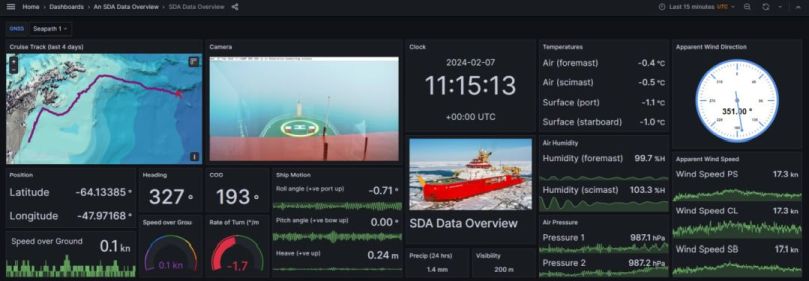Transforming ship-borne science in the polar regions
It’s Antarctic Season 2023/24 and the new British polar research vessel, the RRS Sir David Attenborough, is conducting its first full science season. The multidisciplinary team on board work around the clock investigating processes of global importance, in this case the nutrient and carbon cycling of the ocean. But how do you get a new state-of-the-art ship, bristling with sensors, science cruise-ready? How do you process and manage the hundreds of gigabytes of data being churned out every day, to make them easily useable for a diversity of researchers long into the future, to the benefit of all?
In 2014 the UK Government invested in a new polar ship to maintain Britain’s position at the forefront of Arctic and Antarctic science. Construction began in 2016, as did the work of the NERC EDS. With a wide variety of users, the ship’s capabilities would have to suit everyone’s needs. To capture these, a statement of requirements for the ship's scientific ability was collated. User requirements were collected through an in-person workshop and internationally circulated questionnaire. The outcomes of these activities were used to decide which software and systems to use, and to begin developing data pipelines.
The involvement of both British Antarctic Survey staff (UK Polar Data Centre, PDC) and the National Oceanographic Centre (British Oceanographic Data Centre, BODC and National Marine Facility, NMF) was key. The ship is operated by British Antarctic Survey, with the PDC responsible for data management on board, and BODC is responsible for the long-term data management of some of the processed data, with the NMF bringing experience of capturing data on the other NERC ships.

A crucial piece of software on the ship is the data acquisition system. This takes the data coming in from the ship’s sensors, time stamps it, writes it to disc, adds it to a database, and enables visualisation. NMF have recently developed a data logging system called ‘RVDAS’ (Research Vessel Data Acquisition System). PDC staff worked with NMF to co-develop this software further to enable it to meet the specific needs of the SDA community. Juan Ward, Engineering Manager of Scientific Ship Systems at NOC/NMF said:
“Since starting in 2018, working with BAS on this project has been fruitful and rewarding! We’ve each built on the other's work, learnt lots and continued to evolve the system as needs and technologies change.”
RVDAS was successfully used to capture data from the first NERC BIOPOLE cruise in December 2023. Kat Turner, BAS PhD Student on that cruise, said:
“The RVDAS system allowed for easy access to the high volume of data we produced. With the help of the amazing IT team and data manager I was able to create up-to date plots with the cruise data that were used for efficient planning of the science.”
Through working together we’ve come a long way; the ship is now undertaking grant-funded science in earnest. But these are only the first steps of a long journey. There will always be more work to do, almost all of which requires stakeholder collaboration. Looking ahead, as cruise data is made publicly available and users wish to integrate it into their data products, they will bring new requirements, so the ship’s systems must adapt accordingly.